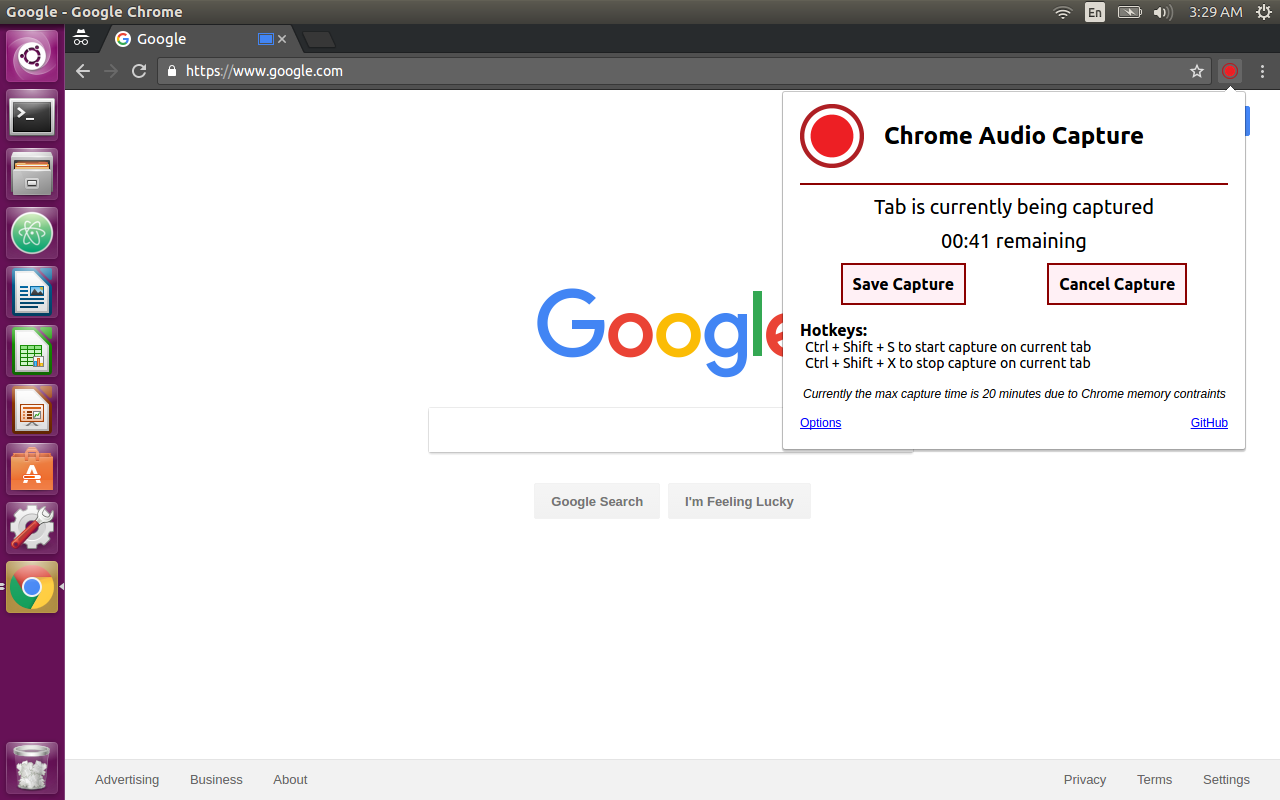Chrome Audio Capture is a Chrome extension that allows users to capture any audio playing on the current tab. Multiple tabs can be captured simultaneously. Completed captures will be downloaded to the chrome downloads folder and will be saved as .wav or .mp3 files. Users will have the option to mute tabs that are currently being captured.
Chrome Audio Capture is available in the Chrome Store
Hotkeys for Windows:
- Ctrl + Shift + S: Start capture on current tab
- Ctrl + Shift + X: Stop capture on current tab
Hotkeys for MAC:
- Command + Shift + U: Start capture on current tab
- Command + Shift + X: Stop capture on current tab
The main interface of the extension
Interface during capture
Several options are able to be changed in the extension:
- 'Mute tabs that are being captured' allows the extension to force any tabs currently being captured to be muted on the system's audio output, but still have its audio captured and encoded to the resulting file.
- 'Maximum capture time' changes the amount of time the extension will capture audio for before timing out, and has a limit to prevent exceeding Chrome's memory limit.
- 'Output file format' allows users to choose whether the resulting file will be encoded into .wav or .mp3
- 'MP3 Quality' is only applicable for .mp3 encodings, and will change the bitrate of the encode. (Low: 96 kbps, Medium: 192 kbps, High: 320 kbps)
To capture the audio in the current tab, I used the chrome tabCapture API to obtain a MediaStream object of the current tab. Next I used the MediaStream object to initialize a recorder that will encode the stream into a .wav file using the Recorder.js library.
chrome.tabCapture.capture({audio: true}, (stream) => {
let startTabId;
chrome.tabs.query({active:true, currentWindow: true}, (tabs) => startTabId = tabs[0].id)
const liveStream = stream;
const audioCtx = new AudioContext();
const source = audioCtx.createMediaStreamSource(stream);
let mediaRecorder = new Recorder(source);To allow audio capture on multiple tabs simultaneously, I stored the tabId of each tab being captured into the sessionStorage object. When a stopCapture command is issued, the extension will check whether the current tab is the same as the tab that the capture was started on, and only stop the specific instance of the capture on the current tab.
const stopCapture = function() {
let endTabId;
chrome.tabs.query({active: true, currentWindow: true}, (tabs) => {
endTabId = tabs[0].id;
if(mediaRecorder && startTabId === endTabId){
mediaRecorder.stop();
mediaRecorder.exportWAV((blob)=> {
const audioURL = window.URL.createObjectURL(blob);
const now = new Date(Date.now());
const currentDate = now.toDateString();
chrome.downloads.download({url: audioURL, filename: `${currentDate.replace(/\s/g, "-")} Capture`})
})By default, using tabCapture will mute the audio on the current tab in order for the capture to take place. To allow audio to continue playing during the capture, I created an Audio object which has its source linked to the ongoing stream that is being captured. In the options menu, users will have the option to keep the tab muted or unmuted during the capture.
chrome.storage.sync.get({
muteTab: false
}, (options) => {
if(!options.muteTab) {
let audio = new Audio();
audio.srcObject = liveStream;
audio.play();
}
});This extension uses LAME MP3 encoder, licensed LGPL. Everything else is under the MIT License.
- Ability to cut parts of the audio off before saving
- Ability to pause and resume captures


